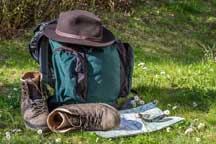Prescription for Wellness: First Aid on the Trail
First Aid on the Trail
By: Dr. Susan Layeux, Boundary Community Clinics
In Boundary County, we head out to forest and river trails to hike, pick berries, find mushrooms, track animals, hunt, ride mountain bikes, snowmobile and ride ATVs. Most excursions will never end in someone needing First Aid. However, as the mother of three Eagle Scouts, I would have to agree with the Boy Scout motto: “Be Prepared”. That is the first key to Trail Safety and First Aid. We need to be aware of our surroundings and the obstacles or animals we may encounter that could result in injury. So I will share some key ways to be prepared.
Carry water. Avoid dehydration by bringing along enough water for the time you plan to spend outside. The higher the temperature, the higher you go in altitude and the more physical you are, the more water you need (even in the winter). The base should be 8 ounces per hour. If you stay hydrated you are less likely to experience Fainting, Heat Stroke and mental dullness that can lead to other injuries. Water can also be used to wash wounds and to cook. Sometimes a simple water bottle per person is enough, but the Camelback backpacks are great if you will be out for hours.
 Pack a basic First Aid kit. This could include antiseptic wipes or alcohol pads (or water), antibiotic ointment, assorted bandages, small tweezers for slivers (or ticks), gauze pads of various sizes, tape (even duct tape), elastic bandage (Ace wrap or Coban wrap that sticks to itself), moleskin or gel pads for blisters, burn cream packets, scissors, safety pins, hand sanitizer, triangular bandage or bandana (makeshift sling). You could even consider disposable non-latex gloves and a CPR breathing barrier if you will be far from help and in a large group. A few baby Aspirin and some Acetaminophen or Ibuprofen can be handy. And many kits come with a small first-aid booklet or guide to how to handle various injuries.
Pack a basic First Aid kit. This could include antiseptic wipes or alcohol pads (or water), antibiotic ointment, assorted bandages, small tweezers for slivers (or ticks), gauze pads of various sizes, tape (even duct tape), elastic bandage (Ace wrap or Coban wrap that sticks to itself), moleskin or gel pads for blisters, burn cream packets, scissors, safety pins, hand sanitizer, triangular bandage or bandana (makeshift sling). You could even consider disposable non-latex gloves and a CPR breathing barrier if you will be far from help and in a large group. A few baby Aspirin and some Acetaminophen or Ibuprofen can be handy. And many kits come with a small first-aid booklet or guide to how to handle various injuries.
On insects. Prevent tick and mosquito bites with proper clothing and your favorite insect repellent. Check for ticks at the end of each day, and remove by grasping the head (if possible) with tweezers and pulling steadily and firmly. Prepare for hornet or bee stings. If allergic, be sure to bring your Epi-Pen. Even if not, bring a few Benadryl 25 mg (diphenhydramine) and take one immediately if there is significant trouble with swelling or breathing. This can also be used if you develop a rash from exposure to poison ivy or other noxious weeds.
Prepare for the weather. Apply sunscreen every 1-2 hours to exposed skin. Use a hat to keep your head cooler in the sun and warmer in the cold. Bring along a rain poncho or even garbage bag if wet weather is possible. Wear layers so that clothing can be adjusted according to changes in temperature through the day (or elevation).
Dress appropriately. Hiking boots provide better ankle support than sneakers on uneven terrain. Helmets are important for high-speed activities like biking, riding ATVs and snowmobiling. Neckerchiefs come in handy for covering skin, getting wet to put around neck to cool down, or to wash or bandage wounds.
General Safety. Always be sure that someone knows where you are going and how long you plan to be away. Carry a flashlight and matches. Carry a cell phone (even if you don’t have service, the phone can often be tracked if you get lost). Always go with a buddy. Back away from potentially dangerous animals while facing them and making a lot of noise.
The Community Health Fair is Saturday, May 12, from 9 am to noon. Stop by our Mountain Trail Safety Clinic. I will be there to answer First Aid questions and give you tips on how to make a Basic First Aid Kit. We live in a beautiful part of the world. Enjoy it – Safely.
###
Susan Layeux, MD is a Primary Care Physician at Boundary Community Clinics and Chief of Staff at Boundary Community Hospital.
